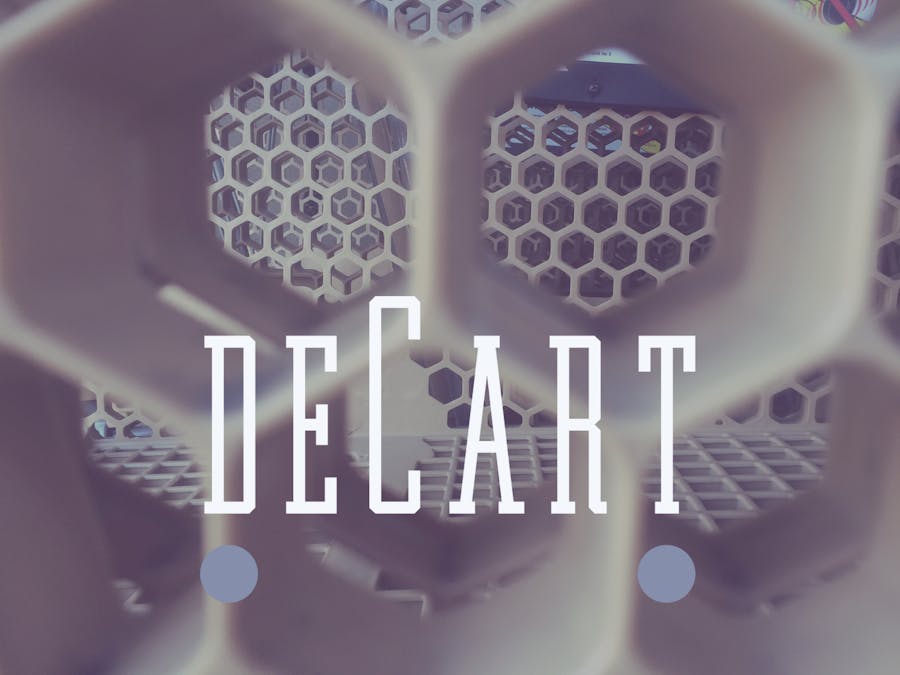Description
deCart is an attachment to a shopping cart that uses social pressure to make the shopping a more productive, connected experience for society as a whole.
Motto: I give, therefore I am. -deCart
Concept Video
List of Materials
Although the entire premise of the project is simple, the implementation, however, is not and requires a lot of patience and system building.
- LCD Display. For us, we used Sparkfun's Basic 16x2 Character LCD - White on Black 5V. See https://www.sparkfun.com/products/709.
- 11 x LED lights. One to indicate selfishness (we used red), the other ten to indicate progress bar (we used yellow; colors are up to your discretion).
- Speaker circuitry and any 8-ohm speaker. Specifically, this breakout board https://www.sparkfun.com/products/11125 and amplifierhttps://www.sparkfun.com/products/11125.
- Bluetooth Modem - BlueSMIRF module from Sparkfun - https://www.sparkfun.com/products/12582.
- Materials needed to construct the box. In our case, we used simple wood.
- Arduino Mega 2560.
- 1x Piezo drum sensor.
Step by Step of our Build Process (Hardware)
Step 1: Familiarize yourself with the Circuitry!
Test each individual circuit and get a handle of the connections. For example, try turning on the LCD display, controlling the progress bar, flashing the selfish light, etc.
Step 2: Construct the Design!
See the roughDesign.DXF file. For us, we made our product by laser cutting wood.
Step 3: The Interface Components
Hot glue all the components that have slits for them! Example: the LCD display, speaker, and the LED lights. Make sure that they fit snugly in and they don't protrude outwards.
Step 4: Wire them!
Each LED light needs to be connected in series to a 200 ohm resistor and not to mention that all their grounds need to be shared. For the LCD display and speaker, I would recommend using a protoboard. For me, I created a makeshift shield for the Arduino Mega, soldered on the speaker circuitry, and had all wires eventually lead into this board.
Step 5: Wire, Wire, Wire.
Don't forget about the Piezo drum sensor and the bluetooth module!
Step 6: Wire.
Hey, when did the sun go up?
Step 7: Cry.
Helps you wire more afterwards.
Step 8: Final wiring and enclosure
After finally connecting all circuitry and ensuring there are no shorts, hot glue the pieces and you're done! Congratulations! :) Use a 9 volt battery to charge your deCart.
App Code
Features - Current and Future
Current
- Ten LED lights that serves as a progress bar for two modes - one for collective goal towards a charity, the other for your personal contributions.
- Knocking on it to change modes.
- A red LED light that marks the "selfishness" of a person. The faster it blinks, the more selfish and vice versa. To slow down the speed, users will have to donate items.
- LCD display showing current contributions and comments.
- Sound effects for successful and the not so successful donations.
- Interfacing with an App that serves as a scanner.
Future>
- Implement snap-on feature and experiment more with design so that it can more easily rest on the handle bar of the shopping cart.
- Also add vibrate and hot/cold feedback.
- Have it smart enough to make shopping cart "smartly" gravitate towards item of interest.



_wzec989qrF.jpg?auto=compress%2Cformat&w=48&h=48&fit=fill&bg=ffffff)

Comments
Please log in or sign up to comment.